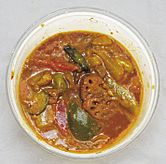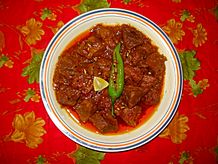South Asian pickle facts for kids
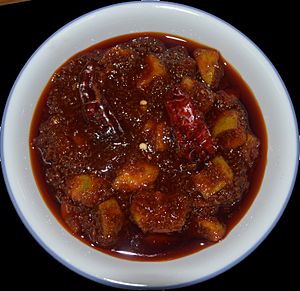
Gujarati-style mango pickle
|
|
| Alternative names | Achar, pacchadi, loncha, oorugai, avakaai |
|---|---|
| Type | Pickle |
| Course | Condiment |
| Place of origin | India, Bangladesh, Nepal, Pakistan, Sri Lanka |
| Region or state | Indian Subcontinent |
| Main ingredients | Fruit (mango, plums), vegetables, or meat |
| Ingredients generally used | Oil, chili powder, spices, mustard seeds, fennel seeds |
| Variations | Acar, Atchar |
A South Asian pickle is a special kind of preserved food. People also call it Achaar, Pachchadi, or Loncha. It comes from the Indian subcontinent. This food is made from different vegetables and fruits. They are kept fresh in brine (salty water), vinegar, or cooking oils. Many Indian spices are added too.
Contents
What's in a Name?
The name for pickles changes depending on where you are in South Asia.
- In Kannada, it's Uppinakaayi.
- In Telugu, it's Avakaya.
- In Tamil, it's Urukai.
- In Marathi, it's Loncha.
- In Gujarati, it's Athanu.
- In Hindi-Urdu, Nepali, and Bengali, it's Āchār.
Long ago, old Sanskrit and Tamil writings used words like Avalehika for pickles. The word Āchār became popular during the time of the Mughal Empire. This word actually comes from Persian. In Persian, Ācār means "powdered or salted meats, pickles, or fruits, kept in salt, vinegar, honey, or syrup."
A Taste of History
People in South Asia have been making pickles for a very long time. Some of the first pickle recipes are found in ancient texts. These include writings from the Ayurvedic and Sangam periods. They even mention mango pickles!
Old cookbooks from the Middle Ages also have pickle recipes. These books describe pickles made from green mango, peppercorns, lemons, and many other plants. One book from 1594 CE even talks about more than fifty kinds of pickles! Some unique pickles were made from edible flowers.
Chili peppers came to India later, brought by Portuguese traders. Before chili peppers, people used Black pepper and Long pepper to make pickles spicy.
What Goes into Pickles?
The ingredients for pickles change from one region to another. But some common ones are limes, lemons, mangoes, ginger, and eggplants. The most important ingredient is often the chilli pepper.
In India, there are two main kinds of pickles. One uses sesame or mustard oil. The other does not use oil. Pickles without oil use salt to pull out water from fruits like green mangoes or lemons. This creates their own salty liquid, called brine. Sometimes, lemon or lime juice mixed with salt is used as brine. Sugarcane vinegar is also used. Some pickles, especially in Gujarat and Rajasthan, even use jaggery (a type of cane sugar) to make them sweet.
Many people make pickles at home during the summer. They let the pickles ripen by leaving them in the sun for up to two weeks. The sun helps to preserve them.
Pickles Across the Regions
India's Diverse Pickles
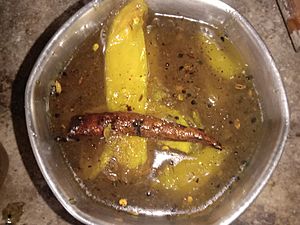
Even with the same main ingredients, Indian pickles taste very different. This is because of how they are made and the spices used. A mango pickle from South India might taste very different from one made in North India. Southern states often use sesame oil and make spicier pickles. Northern states prefer mustard oil.
In Haryana, a northern state, the city of Panipat is famous for making many tasty pickles. Mango, chili, and lemon pickles are popular. But Panipat is known for pachranga (five colors) and satranga (seven colors). These pickles use five or seven different vegetables. They are ripened in mustard oil. Panipat makes a lot of pickles every year. These are sold locally and sent to countries like the UK and USA.
In Southern India, many vegetables are sun-dried with spices. This helps preserve them because the weather is very hot and sunny. Spices like mustard, fenugreek seeds, chili powder, and salt are added. This makes pickles a daily food.
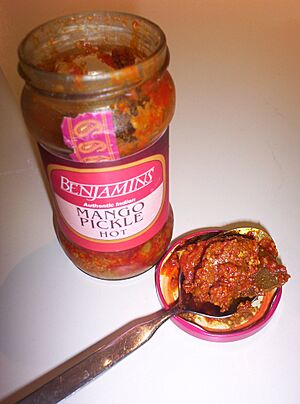
The states of Telangana and Andhra Pradesh are known for their spicy pickles. Unripe mango with garlic and ginger (called āvakāya) is a common food. Gooseberry and lemon pickles are also widely eaten.
In Tamil Nadu, there's a mango pickle called māvaḍu. It's made early in summer when mangoes are tiny. It uses castor oil for a special taste. Another pickle, nārttaṅgai, is made from unripe citrons stuffed with salt.
In Karnataka, a traditional pickle is māvina uppinakāyi. This is a whole, tender mango pickle. It's preserved by drying the mangoes with salt. It tastes very salty and sour.
People in coastal areas of Southern India also pickle fish and meats. In Tamil Nadu, karuvāḍu is made by salting and sun-drying fish. In Kerala, tuna and sardines are chopped and cooked with spices to make mīn acār. Andhra Pradesh and Telangana are famous for their spicy lamb and chicken pickles.
In Gujarat, unripe mangoes, lemon, green chilis, and other local plants are used. Mango pickles here can be salty, hot, or sweet. They use oils like groundnut oil and spices like fenugreek seeds.
Myanmar (Burma) Pickles
In Myanmar, pickles are called thanat. Mango pickle (thayet thi thanat) is the most common. It can be made with green, ripe, or dried mangoes. They are preserved in vinegar, sugar, salt, chili powder, and spices. Mango pickle is often eaten with curries and biryani.
Nepal's Achar
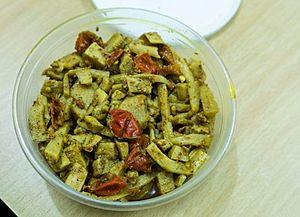
In Nepal, achar is a popular way to preserve vegetables, meat, and fruits. People eat achar with their main meals like Dal-Bhat-Tarkari. Many achar factories in Nepal are run by women. Spices like mustard seeds, timur (Sichuan pepper), and chili powder are used. Some popular Nepali achar include:
- Lapsi achar - Made from Nepalese hogplum.
- Khalpi achar - Ripe cucumber preserved with mustard seed and oil.
- Dalle khursani achar - Nepali round chili pickle.
- Tama achar - Fermented bamboo pickle.
- Gundruk achar - Fermented mustard leaves pickle.
- Mula ko achar - Sun-dried radish pickle.
- Buff achar - Pickled buffalo meat.
- Chicken achar - Pickled chicken.
- Aanp ko achar - Unripe mango pickle.
- Kagati ko achar - Lemon pickle.
Pakistan's Famous Pickles
The Sindh province in Pakistan is known for its shikrarpuri achar and hyderabadi achar. These are eaten all over Pakistan and in other countries. Shikrarpuri achar is thought to have started around the 1600s. The most popular type is a mixed achar with carrots, turnips, onions, cauliflower, chickpeas, garlic, green chillies, lime, and mango.
Sri Lanka's "Achara"
In Sri Lanka, pickles are called "acharu" in Sinhala or "Oorugai" in Tamil. They are also very popular there.
African Atchar
In South Africa and Botswana, Indian pickles are called atchar. They are mostly made from unripe mangoes with different spices. People sometimes eat them with bread.
See also
 In Spanish: Encurtido indio para niños
In Spanish: Encurtido indio para niños


